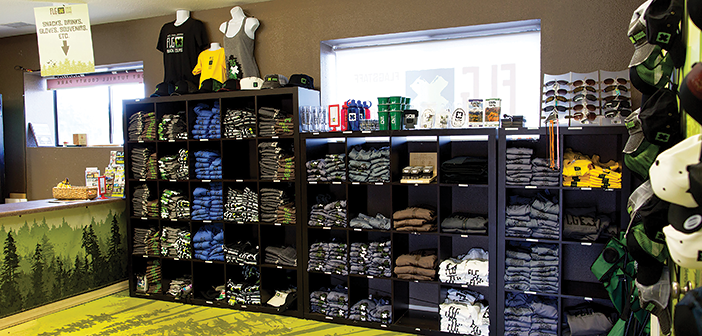Jeremiah Heath, co-manager of tours at Louisville MEGA Cavern, which is home to fully underground zip lines, ropes courses, a bike park, and more, says retail sales account for about 7 percent of its annual income. He stresses the importance of promoting the logo and the tour’s brand—the Cavern’s goal is to “sell merchandise that advertises us nationally and brings people back in.” To that end, the company “tries to have something for everyone,” including shirts, clothing, photos, coffee mugs, and toys for the kids. The Cavern also has a simple snack bar, but mostly as a convenience for its customers and not as a significant driver of revenue.
THOUGHTS ON FOOD
Other properties think bigger when it comes to food. Satiating the appetites of hungry adventure seekers can open up more opportunities to increase revenues.
Bruce Brown, director of zip line operations and training for Royal Gorge Zip Line Tours in Colorado, knows the value a restaurant can have. Royal Gorge’s Whitewater Bar and Grill “is a perfect complement to the packages we put together,” he says. Guests can pay one price for a complete experience that includes a half-day rafting trip in the morning, lunch at the restaurant, and a half-day zip tour to round out the afternoon. “A significant portion of our revenue comes from [selling]packages,” he adds. The tour’s numbers guru, Heidi Anderson, says that the revenue stream is about 40 percent from zip tours, 30 percent rafting, 20 percent Whitewater, 5 percent retail/soft goods, and 5 percent from various rental programs.
The restaurant draws more than just tour guests. Non-adventure-seeking tourists as well as a strong local following keep the seats full on a daily basis.
MERCHANDISING FLOPS
While these operators have found success in selling merchandise, all are learning what works and what doesn’t. Whether it’s the product mix, competition from nearby businesses, or even the weather, there are always challenges.
“Most of our retail sales happen when it’s warm,” Brown observes. This makes it harder to sell hoodies and other cozy items, because that’s not what people are looking for during the summer months.
Flagstaff Extreme has had some items that just don’t sell. “If it’s too much like a giveaway item, people won’t buy it,” Kent says. His example: koozies, which don’t move off the shelf very well.
At Hawaii Forest and Trail, Cohn says a vending machine he installed failed to get much traction, perhaps because a nearby general store provided a better source of grab-and-go snacks.
As a result of experiences like these, Kent’s strategy when adding new items is to start with a small run at first and, if it proves popular and sells quickly, order more the next time. He has also found that if his staff members purchase the merchandise for themselves, that’s a good indicator of style and value.
If these operations have learned one thing for sure, it’s that good merchandising consistently drives ancillary spending. Carrying a mix of thoughtful, quality products with proper branding is key to a successful retail operation. Offering these items in an accessible space with good traffic flow helps fuel that success. From photos to T-shirts, your guests’ desire to remember and show off the unique adventure they just experienced not only generates immediate revenue, but also drives future business.
POPULAR ANCILLARY ITEMS
• moderately-priced sunglasses
• eyeglass retainers
• sunscreen and lip balm
• gloves
• logo hats and T-shirts
• logo mugs and shot glasses
• logo pins and patches
• water bottles and flasks
• energy bars
• snack foods and ice cream
• souvenir photos






